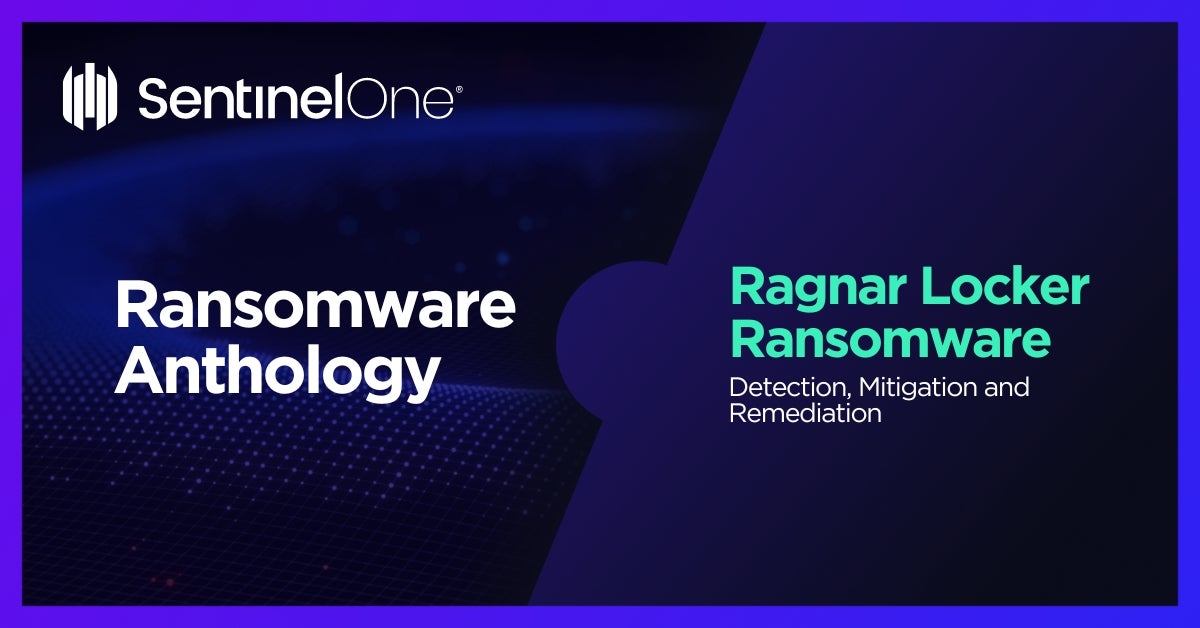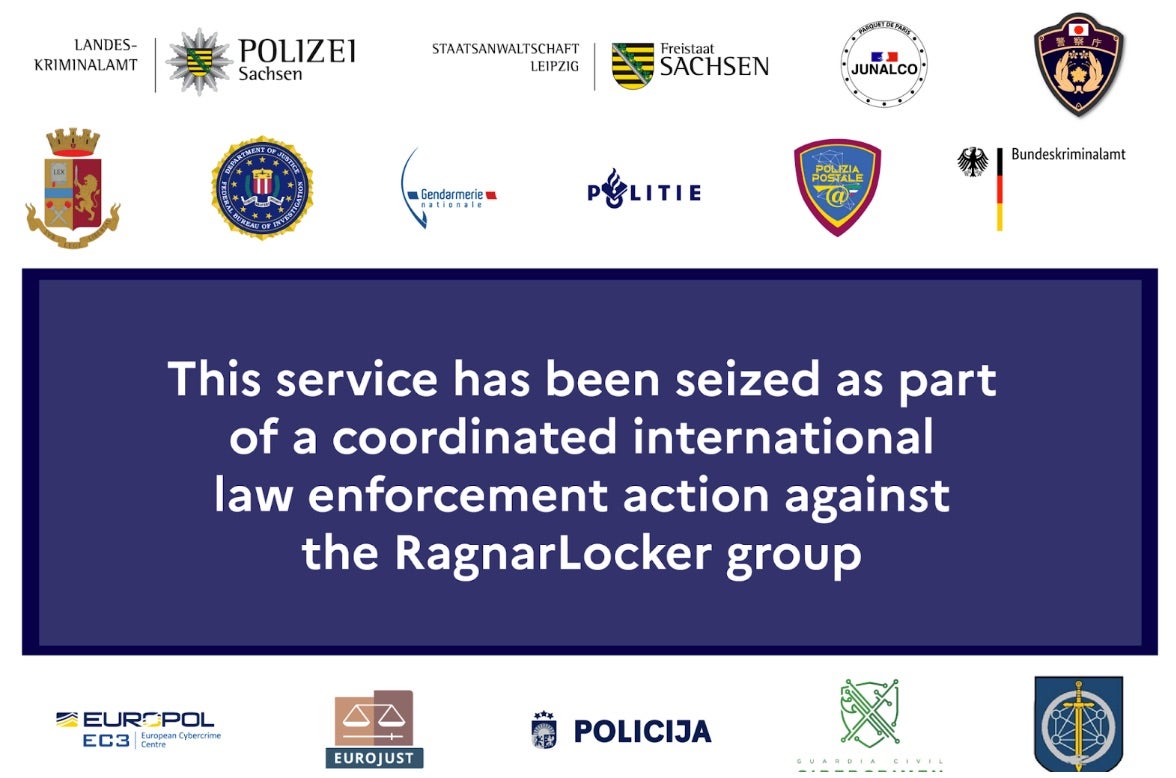Ragnar Locker Ransomware: In-Depth Analysis, Detection, Mitigation, and Removal
Summary of Ragnar Locker Ransomware
Ragnar Locker emerged in December 2019. Ragnar Locker targets corporate networks and engages in multi- extortion – demanding payment for decryption tools, as well as for the non-release of stolen data. Ragnar Locker is a dangerous threat group that does not tolerate the use of “negotiation” or “recovery” companies during ransom negotiations. Furthermore, they often use different ransomware payloads from other malicious developers, keeping their malware up-to-date.

What Does Ragnar Locker Ransomware Target?
Ragnar Locker ransomware typically targets organizations in a variety of industries, including healthcare, government, technology, finance, education, and media. Targeting may vary across affiliates.
Update: On October 20, 2023, full details were announced following a coordinated takedown of Ragnar Locker’s operations. The international effort includes the arrest of a key figure in the overall operation in the Czech Republic along with additional suspects across Spain and Latvia. The French-led operation also saw the seizure of Ragnar Locker’s infrastructure across the Netherlands, Sweden, and Germany. Following this action, Ragnar Locker’s operations have remained dormant.

How Does Ragnar Locker Ransomware Spread?
Ragnar Locker is delivered via Cobalt Strike or similar framework. AtomSilo has also been observed exploiting known vulnerabilities, for example CVE-2017-0213 – a privilege escalation vulnerability in Microsoft Windows. Operators often target exposed RDP services via brute-force attack, or through purchased credential sets.
Ragnar Locker Ransomware Technical Details
Ragnar Locker December 2019, affecting devices running Microsoft Windows operating systems. The operators of Ragnar Locker threaten their victims to not hire negotiators, stating it will be considered as a hostile act.
Ragnar Locker typically delivers malware via RDP or exploitation of other exposed applications/interfaces. It attempts to disable Volume Shadow copies. In addition, Ragnar Locker was one of the early adopters of distribution via ISO file from where the ransomware encrypts the hosts files while running “hidden” within the provided disk image. SentinelOne autonomously prevents, detects, and even remediates this attack.
Ragnar Locker uses RSA2048 and Salsa20 to encrypt and obfuscate their payloads, making it more difficult to analyze. This encryption is designed with performance in mind, ensuring a fast and secure process.
Ragnar Locker will attempt to inhibit system recovery options by disabling/destroying Volume Shadow Copies.
How to Detect Ragnar Locker Ransomware
- The SentinelOne Singularity XDR Platform can identify and stop any malicious activities and items related to Ragnar Locker.
In case you do not have SentinelOne deployed, detecting ransomware requires a combination of technical and operational measures designed to identify and flag suspicious activity on the network. This allows the organization to take appropriate action, and to prevent or mitigate the impact of the ransomware attack.
To mitigate the risk of this Ransomware without SentinelOne deployed, it is important to take a multi-layered approach, which includes the following steps:
- Use anti-malware software or other security tools capable of detecting and blocking known ransomware variants. These tools may use signatures, heuristics, or machine learning algorithms, to identify and block suspicious files or activities.
- Monitor network traffic and look for indicators of compromise, such as unusual network traffic patterns or communication with known command-and-control servers.
- Conduct regular security audits and assessments to identify network and system vulnerabilities and ensure that all security controls are in place and functioning properly.
- Educate and train employees on cybersecurity best practices, including identifying and reporting suspicious emails or other threats.
- Implement a robust backup and recovery plan to ensure that the organization has a copy of its data and can restore it in case of an attack.
How to Mitigate Ragnar Locker Ransomware
- The SentinelOne Singularity XDR Platform can return systems to their original state using either the Repair or Rollback feature.
If you do not have SentinelOne deployed, there are several steps that organizations can take to mitigate the risk of AtomSilo ransomware attacks.
Educate Employees
Employees should be educated on the risks of ransomware, and on how to identify and avoid phishing emails, malicious attachments, and other threats. They should be encouraged to report suspicious emails or attachments, and to avoid opening them, or clicking on links or buttons in them.
Implement Strong Passwords
Organizations should implement strong, unique passwords for all user accounts, and should regularly update and rotate these passwords. Passwords should be at least 8 characters long, and should include a combination of uppercase and lowercase letters, numbers, and special characters.
Enable Multi-factor Authentication
Organizations should enable multi-factor authentication (MFA) for all user accounts, to provide an additional layer of security. This can be done through the use of mobile apps, such as Google Authenticator or Microsoft Authenticator, or through the use of physical tokens or smart cards.
Update and Patch Systems
Organizations should regularly update and patch their systems, to fix any known vulnerabilities, and to prevent attackers from exploiting them. This includes updating the operating system, applications, and firmware on all devices, as well as disabling any unnecessary or unused services or protocols.
Implement Backup and Disaster Recovery
Organizations should implement regular backup and disaster recovery (BDR) processes, to ensure that they can recover from ransomware attacks, or other disasters. This includes creating regular backups of all data and systems, and storing these backups in a secure, offsite location.
The backups should be tested regularly, to ensure that they are working, and that they can be restored quickly and easily.
Ragnar Locker Ransomware FAQs
What is Ragnar Locker ransomware?
Ragnar Locker is a business ransomware variant that has been active since 2020. It encrypts files and threatens to leak stolen data. Victims receive ransom notices named RECOVER_FILES.txt. The ransom is demanded in Monero to avoid traceability.
What encryption algorithms are used by Ragnar Locker?
Ragnar Locker uses AES-256 for file encryption and RSA-2048 for key encryption. They will embed unique keys per victim. Your files remain locked until attackers provide decryption tools. The hybrid approach prevents decryption without paying.
What file extensions does Ragnar Locker append to encrypted files?
Ragnar Locker appends .ragnar_encrypted to encrypted files. For example, “data.xlsx” becomes “data.xlsx.ragnar_encrypted”. They will also leave ransom notes in every folder. You can recognise infections by these extensions and altered desktop wallpapers.
How does Ragnar Locker gain initial access to victim environments?
Ragnar Locker operators use phishing emails with malicious ISO attachments. They will exploit vulnerabilities in RDP and VPN services. You can also get infected via malvertising campaigns. The attackers will use stolen credentials to bypass perimeter defenses.
Does Ragnar Locker disable or delete backup and security tools?
Yes, Ragnar Locker terminates backup-related processes like VSS and SQL services. It will delete shadow copies using vssadmin.exe. Registry edits may disable your security tools. The ransomware will attempt to encrypt network-attached backup drives.
What are the indicators of compromise (IOCs) for Ragnar Locker ransomware?
IOCs include files with .ragnar_encrypted extensions and ransom notes named RECOVER_FILES.txt. They will create registry keys under HKEY_LOCAL_MACHINE\Software\Ragnar. Monitor for connections to IP 45.155.205.2. Sudden spikes in CPU usage during encryption are another sign.
How can organisations detect a Ragnar Locker infection early?
You can detect Ragnar Locker by monitoring for mass file renames. There are alerts for vssadmin.exe deleting shadow copies. They will generate Windows Event Log errors (ID 7031) from terminated services. Network traffic to TOR nodes is a red flag.
What are some security features that can prevent Ragnar Locker attacks?
You must apply application allowlisting to prevent unauthorised executables. Patch RDP and VPN vulnerabilities as soon as possible. There are email filters that prevent ISO attachments. Isolate networks to limit lateral movement. Regular offline backups will protect against data loss.
Are generic antivirus or EDR solutions effective against Ragnar Locker?
Yes, the latest EDR solutions can identify Ragnar Locker’s VM-based activity and suspicious file encryption activities. You must turn on behavior analysis and deploy solutions like SentinelOne Singularity XDR Platform.